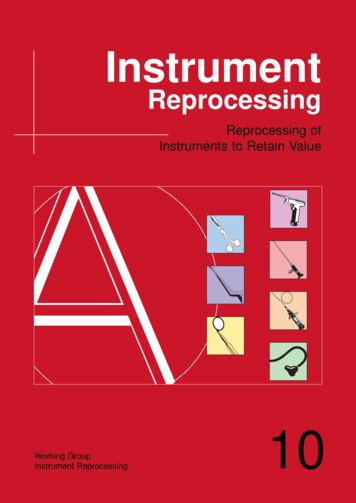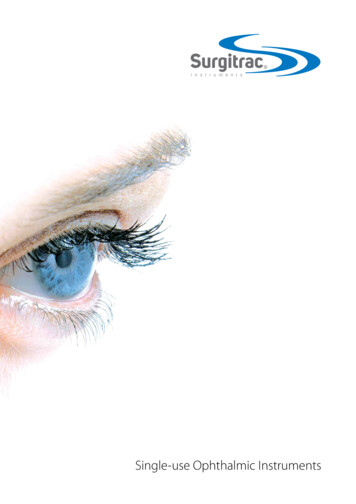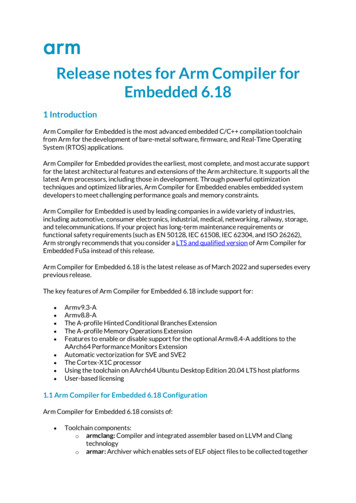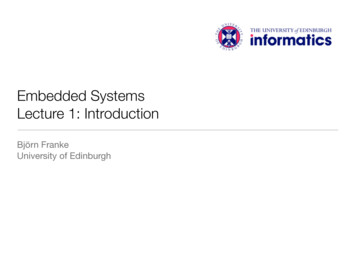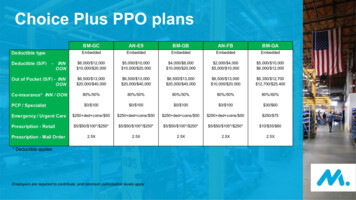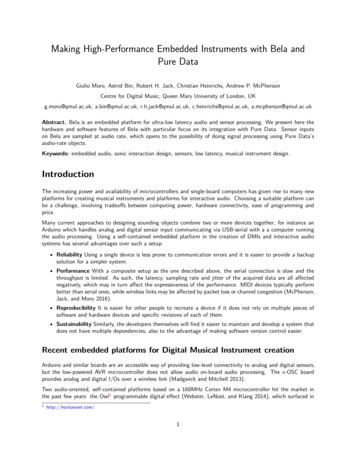
Transcription
Making High-Performance Embedded Instruments with Bela andPure DataGiulio Moro, Astrid Bin, Robert H. Jack, Christian Heinrichs, Andrew P. McPhersonCentre for Digital Music, Queen Mary University of London, UKg.moro@qmul.ac.uk, a.bin@qmul.ac.uk, r.h.jack@qmul.ac.uk, c.heinrichs@qmul.ac.uk, a.mcpherson@qmul.ac.ukAbstract. Bela is an embedded platform for ultra-low latency audio and sensor processing. We present here thehardware and software features of Bela with particular focus on its integration with Pure Data. Sensor inputson Bela are sampled at audio rate, which opens to the possibility of doing signal processing using Pure Data’saudio-rate objects.Keywords: embedded audio, sonic interaction design, sensors, low latency, musical instrument design.IntroductionThe increasing power and availability of microcontrollers and single-board computers has given rise to many newplatforms for creating musical instruments and platforms for interactive audio. Choosing a suitable platform canbe a challenge, involving tradeoffs between computing power, hardware connectivity, ease of programming andprice.Many current approaches to designing sounding objects combine two or more devices together, for instance anArduino which handles analog and digital sensor input communicating via USB-serial with a a computer runningthe audio processing. Using a self-contained embedded platform in the creation of DMIs and interactive audiosystems has several advantages over such a setup. Reliability Using a single device is less prone to communication errors and it is easier to provide a backupsolution for a simpler system. Performance With a composite setup as the one described above, the serial connection is slow and thethroughput is limited. As such, the latency, sampling rate and jitter of the acquired data are all affectednegatively, which may in turn affect the expressiveness of the performance. MIDI devices typically performbetter than serial ones, while wireless links may be affected by packet loss or channel congestion (McPherson,Jack, and Moro 2016). Reproducibility It is easier for other people to recreate a device if it does not rely on multiple pieces ofsoftware and hardware devices and specific revisions of each of them. Sustainability Similarly, the developers themselves will find it easier to maintain and develop a system thatdoes not have multiple dependencies, also to the advantage of making software version control easier.Recent embedded platforms for Digital Musical Instrument creationArduino and similar boards are an accessible way of providing low-level connectivity to analog and digital sensors,but the low-powered AVR microcontroller does not allow audio on-board audio processing. The x-OSC boardprovides analog and digital I/Os over a wireless link (Madgwick and Mitchell 2013).Two audio-oriented, self-contained platforms based on a 168MHz Cortex M4 microcontroller hit the market inthe past few years: the Owl1 programmable digital effect (Webster, LeNost, and Klang 2014), which surfaced in1http://hoxtonowl.com/1
2013, and Axoloti2 , which came out early 2015. The former can be programmed through a C API or can runPure Data patches using the Heavy Audio Tools from Enzien Audio,3 while the latter provides a custom graphicalpatcher which includes DSP modules and can be expanded with C .Raspberry Pi is arguably the most popular single-board-computer in the world and its latest revision 3 featuresa quad-core 1.2GHz 64bit CPU. The CCRMA Satellite distribution4 (Berdahl and Ju 2011) was developed toprovide an efficient audio-oriented environment for the Raspberry Pi.Coala is an audio processing platform based on the BeagleBone Black5 which was presented in (Piéchaud 2014).The software and hardware architecture of Coala were developed for the specific task of modal control6 , whichrequires a very tight feedback loop. The platform is therefore optimized for fast sample-by-sample processing inorder to minimize round-trip latency.Bela: an embedded platform for audio and sensor processingBela7 (formerly known as BeagleRT) is a combined hardware and software environment that consists of a BeagleBone Black with an expansion “cape” (McPherson and Zappi 2015a). It was originally developed for the D-BoxHackable Digital Instrument (Zappi and McPherson 2014) which required multiple low-latency hybrid analogdigital feedback loops (McPherson and Zappi 2015b). Bela combines the connectivity of a microcontroller withthe processing capability of a single-board computer. The cape provides stereo audio I/O including 1W speakeramplifiers, 8 channels each of 16-bit analog I/O, and 16 digital GPIO pins. Bela is open-source hardware andsoftware. Source code and design materials are publicly available.8The Bela software uses a Debian Linux distribution with the Xenomai9 real-time kernel extensions. The Programmable Realtime Unit (PRU), a 200MHz microcontroller on the same chip as the BeagleBone Black CPU,transfers audio and sensor data directly to the hardware, bypassing the kernel drivers. The user’s Bela codetherefore runs at the highest priority of any task on the board, including the Linux kernel itself. This allows audioblock sizes as low as 2 samples, resulting in round-trip audio latency of 1ms (or even down to 100us if using theanalog inputs and outputs rather than the audio converters) (McPherson, Jack, and Moro 2016).On Bela, every analog and digital channel is automatically sampled at audio rates, synchronously with the audioclock. The high sampling rate of the analog and digital channels are unique to Bela and their jitter-free alignmentwith the audio makes it ideal for interactive, intuitive, responsive audio applications.Compared to Axoloti and Owl, Bela has more processing power, while still providing hard real-time performances,with the added convenience of a full Linux OS and while being minimally affected by system load. It is moregeneral-purpose than Coala which addresses the specific field of real-time control, though Coala is capable of evenlower latencies than Bela. On a Raspberry Pi running CCRMA Satellite, despite the high processing power availableon board, audio depends on the standard Linux audio drivers, so that low-latency processing is difficult becauseof the presence of other processes on the board, which may cause underruns at small audio blocksizes even whenthe CPU load is low on average. The BeagleBone Black CPU is less powerful overall but the Xenomai extensionsused in the Bela software allow reliable and consistent performance with sub-millisecond latency. Additionally, thenumber of I/Os available in Bela is greater than those on commonly available Raspberry Pi hats.Bela, providing a large number of I/Os for audio and sensors, power output for loudspeakers, and providing enoughprocessing power to satisfy most needs, entirely fulfills the requirements of a self-contained device, which can beembedded in a stand-alone Digital Musical Instrument or sounding object.Pure Data on BelaPure Data10 (Pd) is a popular open source graphical programming language widely used by musicians and sounddesigners alike, which allows for quick prototyping of sound and sensor mappings. Pd patches are usually run2593 http://enzienaudio.com/4 https://ccrma.stanford.edu/ eberdahl/Satellite/http://www.axoloti.com/6 http://instrum.ircam.fr/smartinstruments/7 http://bela.io8 tp://xenomai.org/ 10 http://puredata.info2
Figure 2: Using a force sensitive resistor with BelaFigure 1: The Bela capewithin Pd itself, or using the shared library libpd 11 . The messaging architecture and the audio engine of Pd wasnot designed to be fast and computationally efficient which can lead performance penalties on platforms withlimited computational power.Heavy Audio Tools The Heavy Audio Tools from Enzien Audio use Pd as a front-end to generate optimisedC code. By analyzing the graph of connections between objects in the Pd code, Heavy is capable of producinghigh-performance vectorized C code which can outperform libpd, making it particularly well suited for embeddeddevices and, more generally, hardware with limited computational power. Heavy is a proprietary, cloud-basedservice and the generated code is licensed under the MIT non-commercial license.The C code produced by Heavy is well-suited to be integrated in a Xenomai environment, as memory is allocatedon the stack, thus avoiding system calls during execution. An automated script takes care of uploading the Pdpatch to Heavy’s server, collect the generated C code and compile it on the Bela board. The entire processgenerally takes less than one minute and most of the time is spent compiling the C code on the BeagleBoneBlack.libpd Minimal modifications were required to port libpd for Bela, these included allowing blocksizes as smallas 8 samples per block and removing socket and disk I/O from the audio thread. Additionally, the calls to thepthread functions were wrapped into Xenomai functions. The resulting shared library can be linked to a Belaprogram and libpd process float() is then invoked from within Bela’s audio callback.Deploying a Pd patch using libpd is virtually instantaneous as it does not require compiling. As soon as the patchis saved on the BeagleBone’s filesystem, the Bela program can be restarted and it will load the updated patch.An added advantage of using libpd is that it is easier to port Pd externals when their source code is available.The same precautions listed above should be taken for new externals in order to make sure that new objects donot introduce Xenomai mode switches in the audio thread 12 .Performance comparison Running an example patch containing a generative audio composition, Heavy codecompiled with the clang 13 compiler uses 26% of the CPU. The same Heavy code, compiled with gcc 14 , occupies43% of the CPU cycles. Running the patch using libpd uses 53% of the CPU.Traditionally, the highest-performance platforms have also placed the most technical demands on the programmer.For many years, custom DSP boards offered the best balance of hard real-time performance and high processingpower, but they were generally programmed in low-level languages using custom development environments. Highlevel music programming languages often come with significant processing overhead. Running Pure Data on 2 ation-to-xenomai-dual-kernel/https://gcc.gnu.org/3
(a) Smoothing(b) Re-centering(c) Differentiating(d) ThresholdingFigure 3: Using Pure Data objects to process sensor dataespecially through the Heavy Audio Tools, provides a convenient graphical environment with minimal sacrifice inperformance compared to programming in C .Sensor processing in PureDataMany interactive systems take approaches where sensors are sampled at low and non-constant rates and the mostrecent frame of sensor data is used to modulate a particular sonic parameter. But in actual fact, the meaning ofsensor data is often deeper, in its behaviour over time or its frequency content. A high sampling rate yields a veryhigh bandwidth of interaction which captures subtle details that might be lost at lower sample rates. Though allthe same techniques could be implemented at control rate, audio-rate sensor data can help reorient the designer’sthinking to become more aware of these possibilities. When using Bela with Pd, this allows to conveniently processsensor signals using audio-rate objects. Some examples include: Smoothing Some sensors are inherently noisy, for instance a potentiometer may generate high-frequencynoise when it is actuated, or an infra-red optical sensor may be subject to transient perturbations from otheremitting sources. The noise in the sensor readings may leak into the audio signal, depending on the signalflow. An easy approach to remove high-frequency noise is to apply a low-pass filter with an appropriatecut-off frequency, as in 3a. Re-centering Readings from accelerometers and other sensors have inherent DC-offsets which may beundesirable for certain applications. A quick way of removing them which does not require calibration isusing an high-pass filter with an appropriate cut-off frequency, as in Figure 3b. Differentiating Some sound-generator parameters are better controlled using the velocity of a sensor reading, rather than with the raw reading. A high-pass filter with a cut-off frequency of 0, properly rescaled canused for this purpose, as in Figure 3c. Thresholding A more complicated example in Figure 3d shows how to combine full-wave rectification,smoothing, DC shift and constrain to threshold a signal.ConclusionThere are several tradeoffs involved in different digital musical instrument design tools: processing power, latency,connectivity, sensor bandwidth, ease of programming and accessibility. With any of the programming environments,4
Bela brings together the connectivity and CPU power of an embedded Linux computer with the low latency andprecise synchronisation of a microcontroller and brings a high-bandwidth dimension to sensor processing. Usingeither the Heavy or the libpd environments, Bela is also suitable for rapid prototyping using the widely-used PureData graphical programming language, with full access to both audio and sensors.Acknowledgements. This work is supported by grants EP/K032046/1, EP/K009559/1 and EP/L019981/1from the UK Engineering and Physical Sciences Research Council and the Queen Mary Centre for Public Engagement.ReferencesBerdahl, Edgar, and Wendy Ju. 2011. “Satellite CCRMA: A Musical Interaction and Sound Synthesis Platform.”Proceedings of the International Conference on New Interfaces for Musical Expression. Oslo, Norway, 173–178.Madgwick, Sebastian, and Thomas J Mitchell. 2013. “x-OSC: A versatile wireless I/O device for creative/musicapplications.” SMC Sound and Music Computing Conference. Stockholm, Sweden: KTH Royal Institute ofTechnology.McPherson, A. P., and V. Zappi. 2015a. “An environment for submillisecond-latency audio and sensor processingon BeagleBone Black.” Audio Engineering Society Convention 138. Audio Engineering Society.McPherson, Andrew, and Victor Zappi. 2015b. “Exposing the Scaffolding of Digital Instruments with HardwareSoftware Feedback Loops.” Proceedings of the International Conference on New Interfaces for MusicalExpression. Baton Rouge, Louisiana, USA: Louisiana State University, 162–167.McPherson, Andrew P., Robert H. Jack, and Giulio Moro. 2016. “Action-Sound Latency: Are Our Tools FastEnough?” Proceedings of the International Conference on New Interfaces for Musical Expression. Brisbane,Australis.Piéchaud, Robert. 2014. “A Lightweight C Real-Time Active Control Framework.” 16th Real Time LinuxWorkshop, October 12 to 13, 2014 at the CCD Congress Center Dusseldorf collocated with LinuxCon Europein Dusseldorf, Germany.Webster, Thomas, Guillaume LeNost, and Martin Klang. 2014. “The OWL programmable stage effects pedal:Revising the concept of the on-stage computer for live music performance.” Proceedings of the InternationalConference on New Interfaces for Musical Expression. London, United Kingdom: Goldsmiths, University ofLondon, 621–624.Zappi, V., and A. McPherson. 2014. “Design and Use of a Hackable Digital Instrument.” Proceedings of theInternational Conference on Live Interfaces. Lisbon, Portugal, 208–219.5
The BeagleBone Black CPU is less powerful overall but the Xenomai extensions used in the Bela software allow reliable and consistent performance with sub-millisecond latency. Additionally, the number of I/Os available in Bela is greater than those on commonly available Raspberry Pi hats. Bela, providing a large number of I/Os for audio and .



